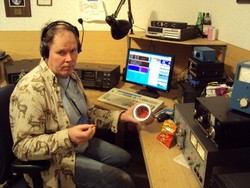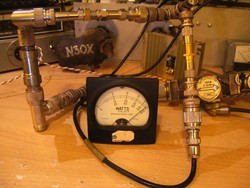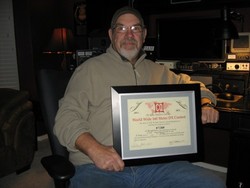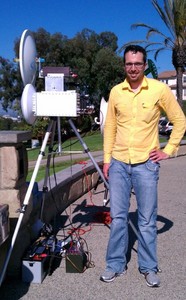 January 18, 2012 Editor: Ward Silver, NØAX | |||||||
IN THIS ISSUE
NEW HF OPERATORS - THINGS TO DO If you've not yet tried 160 meters thinking that the antennas are too big and the static crashes too loud - give the band another try during the upcoming CQ Worldwide 160 Meter contest. You'll find lots and lots of stations ready to pull your signal into their logs! BULLETINS There are no bulletins in this issue. BUSTED QSOS I'll blame these on the effects of holiday nog! The correct URL for K5LXP's 6x2 antenna switch is here - thanks to Doug KR2Q and others who spotted the extra %20 at the end of the URL. The photos of N6RO and K3EST & Junko should have been credited to Bob N6TV instead of mutual friend Dean N6BV. And the Contest Super Suite begins on Wednesday, not Thursday, of the Dayton Hamvention says John K9JK. CONTEST SUMMARY Complete information for all contests follows the Conversation section January 21-22
January 28-29
The Florida Contest Group will be sponsoring the 2012 Orlando Contest Dinner at the Orlando Hamcation convention. The dinner will take place on February 10, 2012 at 6pm at the American Legion Hall at 2101 Lee Road in Orlando. After dinner, hear an address by new NCJ Editor Kirk Pickering, K4RO. There will also be a hospitality suite with CW and SSB copying contests. For questions and to order tickets, contact Chris WF3C.
If you're planning on attending the Contest Dinner during Dayton Hamvention, the North Coast Contesters are happy to announce that CQ Contest Hall of Fame member Larry "Tree" Tyree, N6TR will be the featured speaker. It's possible that Tree will share his secrets of winning contesting. When not chasing new countries on 160 meters, Tree is also a log checker for the ARRL, CQ, and WRTC. With a distinguished and interesting contest resume, his talk is sure to be interesting! (Thanks, Tim K3LR) Todd KC9BQA has made several new web posts to that are helpful to newer VHF+ contesters, such as the articles titled VHF Contesting School. The articles are broken down into bite-sized pieces geared toward getting a novice VHF+ operator comfortable calling "CQ Contest". Firefox users may be interested in the Propfire utility that displays Solar Flux, A, and K indices at the bottom of the browser window. (Thanks, Chuck AF4O) Baby boomers will recall the WPE call signs for SWL (short-wave listener) stations - and they are making a comeback! On January 1, Popular Communications magazine launched the Pop'Comm Monitoring Station (PCMS) program, reminiscent of Popular Electronics magazine's popular Monitor Station (WPE) program of more than 50 years ago. So far, more than 300 SWLs, scanner buff, and digital communications enthusiasts have signed up. This was a common path to ham radio - why not suggest it to an unlicensed friend or relative? (Thanks, Popular Communications Editor, Richard KI6SN) Just in time, a new version of the VHF Super Check Partial and Prefill databases for the ARRL January 2012 VHF Contest are now available from W9ZRX. WRTC 2014, Inc., host of the 2014 World Radiosport Team Championship competition, is pleased to announce that L. Dennis Shapiro, W1UF, has joined the WRTC2014 Advisory Council. The Advisory Council consists of individuals who have experience in the execution of major events and are willing to provide significant financial resources to the project. Dennis is a lifelong New Englander and maintains two stations - one in the Boston area and one on Nantucket Island. An active DXer and occasional contester, Dennis explains his motivation for joining the Advisory Council, "I am interested in building international friendships and see WRTC as furthering that goal." (Thanks, WRTC-2014 Co-Chair, Randy K5ZD) The first Potomac Valley Radio Club (PVRC) webinar of the year will feature Tim Duffy, K3LR, Chancellor of Contest University (CTU) discussing the 2012 course line up, list of professors, and the WWROF endorsed Contester's Code of Ethics. CTU welcomes six new professors this year. Click the "Upcoming Webinars" link for more information and to register for this free talk to be conducted on 30 January. (Thanks, Ken K4ZW)
A great way to display your QSLs is by scanning them and putting the images into a digital picture frame. Most digital picture frames depend on something like a USB Flash Card for their input. A 4-Gbyte Flash Card costing a few dollars will hold thousands of high-res images of scanned QSL cards. (Brian N9ADG and Chuck KØTVD) Web Site of the Week - Imus Geographics is having a hard time keeping up with demand for their new and highly rated new map of the United States as described in this Slate.com story. I know that hams love maps and this one captured my interest (and order) right away! WORD TO THE WISE QNZ - "Zero beat your signal with mine." A Q-signal sent by net control stations but that could also be used in many contests. For example, clear the RIT before calling a station. It's certainly easy to forget, leaving you potentially well outside the passband of a station's receiver on a crowded band. Some contesters even add the software commands to clear the RIT in their operating macros so they don't forget. (Thanks, Tom W8TK) The link to information on the 1948 Gatti-Hallicrafters DXpedition created some interest - here is another good website about it. W7LR was also featured in this two-page (page 1, page 2) newspaper story and in his own words on his WWII experiences as a radio operator - the images will load somewhat slowly. (Thanks, Tree N6TR) The Semiconductor Museum is a great way to spend some time - we take these tiny marvels for granted today but they changed the world in a big way. My favorite is the section on my old friend, the 2N2222, of which I used many, ruined more than a few, and still specify now and then today. (Thanks, George W2VJN) If you enjoyed those photos by Bob N6TV in the last issue, there are many more faces of the Northern California Contest Club members online. (Tom K6AET's photo is my favorite!) The montage was assembled by John K6MM - your club might want to consider something similar. A whole batch of ARRL contest results are hitting the 'net including the IARU HF Championship, September VHF QSO Party, and 10 GHz Cumulative contests. These all include extra content beyond the QST article such as graphs, photos, tables, and all of the line scores. The IARU results may take another day or two before posting but look for them shortly. (Thanks, ARRL Contest Branch Manager, Sean KX9X) The final tally of 5,438 logs received for the ARRL 10 Meter Contest is an all-time record for ANY of the ARRL contests - single-band, multi-band, domestic, DX, HF, or VHF. Wow! (Thanks, Sean KX9X)
2011 Nebraska QSO Party results have been posted with final rules for the 2012 contest to follow shortly. (Thanks, Heartland DX Association webmeister, Jeff NEØDX) CQ Worldwide 160 Contest Manager, Andy N2NT, announces the posting of the 2011 CQ 160 contest results. This package includes corrections to the print article, such as missing scores and adds a trophy list. Certificates have already been mailed and plaques are in the process of being made up. The record list will be updated soon. Log checking reports can be obtained by emailing Andy with the call sign you used and the mode of the contest you entered. Don AA5AU has written up his experiences during the recent ARRL RTTY Roundup in which he finally cracked the 2000-QSO barrier for low power entries. If you want to know more about how the high-scoring stations make those big totals, here's one example. WRTC-2014 standings have been updated to include the official results from CQ WPX SSB, EUHFC, and NAQP CW and SSB. Problems with the NA Sprint scores are being fixed. Updated Excel spreadsheets for each Selection Area have been posted, as well. Thanks to Marek, SQ2GXO for his continuing efforts to track both final and claimed scores on his website WRTC-Rank. Updates will continue to appear periodically as various contest results are made public. (Thanks, WRTC-2014 Team Selection Director Dan K1TO Bob KØRC's Log Analyzer for the ARRL RTTY Roundup contest, version 2.0.2, can be downloaded and includes minor enhancements added since last year, including one-click Import procedures for Cabrillo-formatted logs. OPERATING TIP While these tips on contest logging were written for the NAQP contests, NAQP Contest Manager, Bruce WA7BNM's suggestions make a whole lot of sense for any contest - before, during, and after. Single-band contesters will be the first to attest that effective listening while transmitting on the same band is difficult to achieve due to transmitter noise and sheer overload. PAØSIM has taken a run at the problem with this two-transistor phaser for 80-10 meters. (Thanks, Martin OK1RR) A favorite foot-warming fixture in many ham shacks, this article by VA7JW provides a detailed accounting of the venerable Heathkit Cantenna dummy load. (Thanks, Jim VE7FO) Protecting dc-powered designs against reverse polarity power supplies takes many forms. Terry WAØITP captured some of the most common techniques in his collection of circuit sketches. One will surely be right for you - or at least spark an idea, so to speak. Just in case you need some help to grow your HyGain antennas, Tom K1KI found this helpful website. With the CQ 160 contests coming up shortly, here's a simple receive antenna recommended by Tim K3LR. The VE3DO loop is also straightforward to build and install, making it a good "temporary" antenna. Diane VA3DB has started a Ham Radio Builder List for anyone interested in homebrew electronics. "Builders" is the term in vogue for folks that like to build rather than buy and that certainly fits a lot of hams - whether by choice or necessity. The website is intended to collect and publish short and simple articles with lots of photos and good instructions. (From AMSAT newsletter ANS-008) If you are surprised to find your Windows PC assigning virtual COM ports with very high numbers - it's a consequence of the way Windows tracks and manages COM ports created by external accessories. Even if you are not using that particular accessory any more, Windows remembers and reserves a COM port for it. This occasionally wreaks havoc with applications such as logging software. To regain control of your COM port assignments, check out this Microsoft Support article. It's also noted in the N1MM contest logging software manual. A free tool called USBDeview can also be used to uninstall USB drivers for devices that you no longer use. (Thanks, Rick N6XI, Bob N6TV and Steve N2IC) To protect a receiver from dc voltages on feed lines for powering external devices and prevent creating intermod in a receive-only devices such as a signal splitter, Frank W3LPL makes the following suggestions. "Use a well over-rated dc blocking capacitor, this is not an application to save a few pennies by using a marginally rated capacitor. You should also use a choke to ground with a high current rating to protect your receiver if the capacitor shorts out. A choke wound with #18 wire on a ferrite core will guarantee that your receiver won't be trashed if the capacitor fails. It's a good idea to place capacitors in series with all three ports of a "magic-T" 3 dB splitter. The ferrite cores in commercially made splitters are very small, if even a small amount of 60 Hz ac current flows through the core it will saturate causing intermod problems. In a multi-operator station, a band-pass filter should be installed to protect the splitter from strong signal saturation, also resulting in intermod problems. You can avoid splitter intermod problems by building your own splitter with large ferrite cores, but you can usually avoid that by using band-pass filters and capacitors to protect the splitter from saturation."
Steve W3AHL notes two common causes of excessive loss in PL-259 connectors - "a solder ball on the end of the center pin, spreading the mating female contacts. After a few insertion cycles a cheap SO-239 may read 2-5 ohms through the center pin. Then there are the connectors where someone scraped all the [the center pin] with a knife, taking all the plating with it." The moral of the story is to assemble the connector correctly without excess solder. Technical Web Site of the Week - Dan N3OX has an interesting webpage full of projects and measurements, such as a tunable short vertical antenna that uses a novel mechanism to vary its geometry. The animations of energy being radiated from an antenna are also captivating! (Thanks, Steve G3TXQ) Spanning the Bands Just this week, a whole batch of ARRL contest results hit the web, covering quite a range of spectrum. The 10 GHz Cumulative Contest and September VHF QSO Party results capture activity on the short wavelengths and the IARU HF Championship results chronicle operating feats all the way at the other end of our allocations. (The IARU results should be up shortly if they are not posted by the time this newsletter is published.) From 1.8 MHz to 78 GHz in one set of results is pretty impressive when you think about it - four and a half orders of magnitude. Yet here were hams pushing the limits of propagation and electronics, trying for distance, distance, and more distance!
This certainly seems to indicate that we are fulfilling our charter as stated in FCC Part 97.1 - to push the boundaries of the radio and communications art. Whether the operators are trying to overcome short antennas and static or pencil-thin beam angles and atmospheric absorption, that they are able to accomplish what they do is nothing short of amazing! How cool is it that a 160 meter signal can be perfectly timed to hit a sunrise opening lasting less than a minute to a location on the other side of the planet? How cool is it that signals at 78 GHz - a wavelength of 3.8 mm - can be beamed across a 2 km path...for fun? And all those other bands in between - bouncing signals off of airplanes, meteors, ionospheric ions and electrons! I can envision a contest in which "all-band" really means "all of the bands". Can you imagine how a rover station for such a contest would appear, festooned with radiating appurtenances and fixtures and, dare I say, doo-dads all fizzing with RF, both outbound and inbound? Extraordinary! Running the bands would take on a whole new scope with such a station on either end.
It's kind of ironic that the only event that supports such an exchange is actually not a contest - it's the annual ARRL Field Day. Perhaps the W3AO monster-multi crew will lead the way for others to follow? To me, the scope of radiosport here at the beginning of ham radio's second century is really exciting. More bands than ever, digital modes by the bucket load, new hams flocking to phone and CW and setting log submission records with each passing year. Perhaps one day soon amateurs will be granted an allocation at even longer wavelengths and I know for a fact that hams are already experimenting with signals in the hundreds of GHz! Our call signs will still be crackling over the air waves no matter what the frequency or color as the laser operators tunnel busily down to meet the mm-wavers tunneling busily up. Wherever there is an electromagnetic niche to be explored, expect to find a ham there - trying for ever-longer, ever-more-difficult QSOs in the quest for DX that is as old as radio. QRZ? 18 January through 31 January An expanded, downloadable version of QST's Contest Corral in PDF format is available. Check the sponsor's Web site for information on operating time restrictions and other instructions. HF CONTESTS North American QSO Party--Phone, from Jan 21, 1800Z to Jan 22, 0600Z. Bands (MHz): 1.8-28. Exchange: Name and S/P/C. Logs due: 14 days. Rules Locust QSO Party--CW, from Jan 18, 0200Z to Jan 18, 0300Z. Bands (MHz): 3.5-7. Frequencies: 3.553, 7.053. Exchange: Name, state or province or 'DX'. Logs due: Jan 31. Rules Linc Cundall Memorial CW Contest--CW, from Jan 18, 2300Z to Jan 19, 2300Z - Multiple operating periods. Bands (MHz): 1.8-7. Exchange: See Web site. Logs due: 30 days. Rules NAQCC Monthly QRP Sprint--CW, from Jan 19, 0130Z to Jan 19, 0330Z. Bands (MHz): 3.5-14. Monthly on 2nd Tuesday or 3rd Wednesday local time (alternating). Exchange: RST, S/P/C, and NAQCC mbr nr or power. Logs due: 4 days. Rules LZ Open Contest--CW, from Jan 21, 0000Z to Jan 21, 0400Z. Bands (MHz): 3.5, 7. Exchange: 6-digit serial and serial from previous QSO. Logs due: 30 days. Rules YLISSB QSO Party--Phone, from Jan 21, 0000Z to Jan 22, 2359Z. Bands (MHz): 1.8-28. Exchange: Call sign, RS(T), ISSB number. Logs due: Mar 18. Rules HA DX Contest--Phone,CW, from Jan 21, 1200Z to Jan 22, 1200Z. Bands (MHz): 1.8-28. Exchange: RS(T) and serial. Logs due: 30 days. Rules UK DX RTTY Contest--Digital, from Jan 21, 1200Z to Jan 22, 1200Z. Bands (MHz): 3.5-28. Exchange: RST and serial. Logs due: 30 days. Rules Feld-Hell Gridloc Sprint--Digital, from Jan 21, 1600Z to Jan 21, 1800Z. Bands (MHz): 1.8-28. Monthly on 3rd Saturday. Exchange: RST, S/P/C, Feld-Hell member nr. Logs due: 7 days. Rules International United Teenager Contest--Phone,CW, from Jan 22, 0900Z to Jan 22, 1500Z. Bands (MHz): 3.5-28, 144/432/1.2G. Exchange: RS(T) and age or "RT". Logs due: 30 days. Rules CQ WW 160 Meter Contest--CW, from Jan 27, 2200Z to Jan 29, 2200Z. Bands (MHz): 1.8. Exchange: RST and S/P/C. Logs due: Feb 28. Rules REF French Contest--CW, from Jan 28, 0600Z to Jan 29, 1800Z. Bands (MHz): 3.5-28. Exchange: RST and serial or department ID. Logs due: 30 days. Rules BARTG RTTY Sprint--Digital, from Jan 28, 1200Z to Jan 29, 1200Z. Bands (MHz): 3.5-28. Exchange: Serial. Logs due: Mar 1. Rules UBA Contest--Phone, from Jan 28, 1300Z to Jan 29, 1300Z. Bands (MHz): 3.5-28. Exchange: RS, serial, and ON province. Logs due: 2 weeks. Rules Winter Field Day--Phone,CW,Digital, from Jan 28, 1700Z to Jan 29, 1700Z. Bands (MHz): 1.8-28, 50+. Exchange: Call sign, RS(T), category, local temp. Logs due: Feb 28. Rules WAB Top Band Phone Contest--Phone, from Jan 28, 1900Z to Jan 28, 2300Z. Bands (MHz): 1.8. Exchange: See Web site. Logs due: 21 days. Rules Classic Exchange--CW, from Jan 29, 1400Z to Jan 30, 0800Z. Bands (MHz): 1.8-28, 50, 144, Frequencies: CW 1.810, 3.545, 7.045, 14.045, 21.135, 28.050, 50.100, 144.100 . Exchange: RST, QTH, model of rcvr and xmtr. Logs due: 30 days. Rules QRP Winter Fireside SSB Sprint--Phone, from Jan 29, 2000Z to Jan 29, 2359Z. Bands (MHz): 3.5-28. Frequencies: QRP calling frequencies. Exchange: RS, S/P/C, QRP ARCI number or power. Logs due: 14 days. Rules VHF+ CONTESTS ARRL January VHF Sweepstakes--Phone,CW, from Jan 21, 1900Z to Jan 23, 0400Z. Bands (MHz): 50+. Exchange: Grid square. Logs due: Feb 22. Rules International United Teenager Contest--Phone,CW, from Jan 22, 0900Z to Jan 22, 1500Z. Bands (MHz): 3.5-28, 144/432/1.2G. Exchange: RS(T) and age or "RT". Logs due: 30 days. Rules Winter Field Day--Phone,CW,Digital, from Jan 28, 1700Z to Jan 29, 1700Z. Bands (MHz): 1.8-28, 50+. Exchange: Call sign, RS(T), category, local temp. Logs due: Feb 28. Rules Classic Exchange--CW, from Jan 29, 1400Z to Jan 30, 0800Z. Bands (MHz): 1.8-28, 50, 144, Frequencies: CW 1.810, 3.545, 7.045, 14.045, 21.135, 28.050, 50.100, 144.100 . Exchange: RST, QTH, model of rcvr and xmtr. Logs due: 30 days. Rules LOG DUE DATES 18 January through 31 January
ARRL Information Click here to advertise in this newsletter. Your One-Stop Resource for Amateur Radio News and Information ARRL membership includes QST, Amateur Radio's most popular and informative journal, delivered to your mailbox each month. Subscribe to NCJ - the National Contest Journal. Published bimonthly, features articles by top contesters, letters, hints, statistics, scores, NA Sprint and QSO Parties. Subscribe to QEX - A Forum for Communications Experimenters. Published bimonthly, features technical articles, construction projects, columns and other items of interest to radio amateurs and communications professionals. Free of charge to ARRL members: Subscribe to The ARRL Letter (weekly digest of news and information), the ARES E-Letter (monthly public service and emergency communications news), Division and Section news -- and much more! ARRL offers a wide array of products to enhance your enjoyment of Amateur Radio. Visit the site often for new publications, specials and sales. Donate to the fund of your choice -- support programs not funded by member dues! Reprint permission can be obtained by sending email to permission@arrl.org with a description of the material and the reprint publication. ACKNOWLEDGEMENTS ARRL Contest Update wishes to acknowledge information from WA7BNM's Contest Calendar and SM3CER's Contest Calendar. | |||||||












